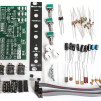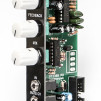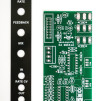Important Links
Product Page
Store Page
Assembly Instructions
Bill of Materials
Schematic
Capacitor and Resistor Lookup Guide
 |
 |
 |
The ECHO (formerly known as EKO) is a very unique echo using the PT2399 IC featuring Voltage Controlled Rate. Manual controls for Rate, Feedback, and Mix. Beautiful and bizarre, CV modulation of the rate brings in ghostly pitch bent sounds to metallic reverbs. An effects module that everyone needs in their rig.
Product info:
- Rate range: 30-190mS
- 4HP
- Voltage-controlled rate
- Self-oscillating feedback
- Mix control
- Hand-assembled in Portland, Oregon



17 Comments